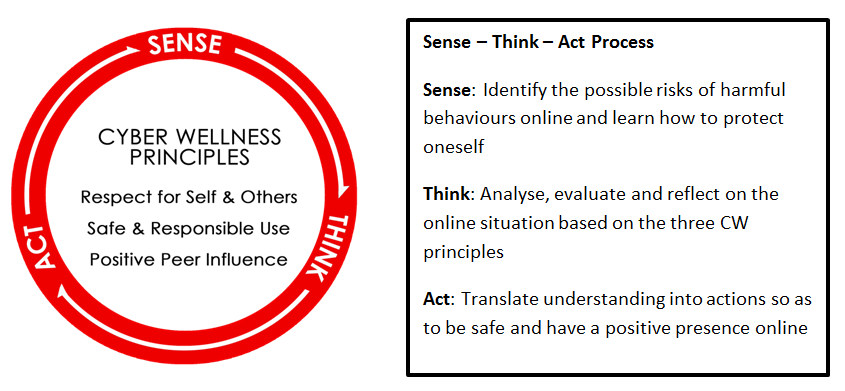Cyber Wellness
Cyber Wellness
What is Cyber Wellness?
Cyber Wellness (CW) refers to the positive well-being of Internet users. It involves an understanding of online behaviour and awareness of how to protect oneself in cyberspace. The focus of CW is about helping students to become responsible digital learners. When navigating cyberspace, students should demonstrate respect for self and others and practise safe and responsible use. Students should also be a positive peer influence by harnessing technology for collaboration, learning and productivity, as well as advocating positive use of technology for the good of the community.
MOE’s Cyber Wellness Framework
MOE uses the CW framework to develop the child’s instinct to protect and empower him to take responsibility for his own well-being in cyberspace. The three principles, ‘Respect for Self and Others’, ‘Safe and Responsible Use’ and ‘Positive Peer Influence’ when adhered to will anchor a child’s well-being in cyberspace as he will then be able to make careful and well-considered decisions.

Victoria School’s Cyber Wellness Education
Cyber Wellness (CW) Education in Victoria School comprises a) CW lessons in the formal curriculum and b) school-wide programmes (e.g. CW assembly talks, Peer Support Leaders’ CW session) to reinforce the importance of CW and its messages.
Victoria carries out CW lessons in the CLE curriculum which seeks to equip students with life-long social-emotional competencies and sound values so that they can become safe, respectful and responsible users of Information Communications Technology (ICT). Topics covered in the CW lessons include:
- Online Identity and Expression
- Balanced use of ICT
- Netiquette
- Cyber Bullying
- Online Relationships
- About the Cyber World
- Handling Online Content and Behaviour
- Cyber Contacts
Tips for Parents
To complement the cyber wellness curriculum in schools, parents can set a good example at home in the use of technology and play an active role in guiding our children to navigate in cyberspace

- Spend time with your child by carrying out family activities such as sports and outdoor activities so that your child has a healthy and balanced lifestyle.

- Manage your own digital habits such as avoiding extensive use of technology and avoiding use of technology during meal times.
- Show your child safe, responsible and respectful behaviour when sharing, collaborating and creating online.
 Some basic rules could include the following:
Some basic rules could include the following:
Dos:
- seek permission before using computing devices
- have a time limit for the use of computing devices
- practice netiquette on the Internet
- respect intellectual property right
- follow rules and terms of use of different websites
Don’ts:
- access websites that have age restrictions (for e.g. many social media sites have age limit for setting up accounts to comply with international regulations on children accessing social media).
- share password with others
- share personal information online
- meet strangers face to face without parents’ knowledge
- spread rumours and say mean things online

- Surf the Internet with your child so that you know what he does online and whether he is involved in age-appropriate activities. This will help to hone your child’s skills to translate his understanding into actions which he can later apply should he face similar situations.
- Highlight to your child not to respond to anyone who says something inappropriate and he should immediately leave any site if he feel uncomfortable.

- Get your child to share with you his favourite online websites, things he do online and what is cool amongst his friends.
- Talk to him about his online experiences. (For example, discuss about the benefits and risks of the Internet, share how people connect and communicate with one another through the Internet).
- Let your child know that it is alright to ask you questions or talk to you if he run into problems with someone online.

